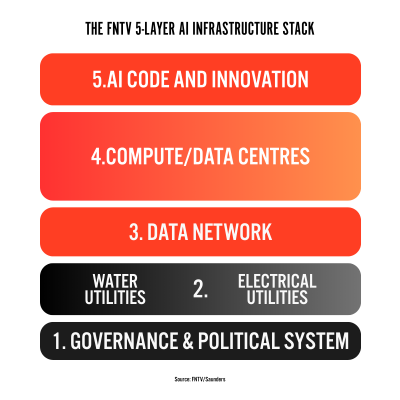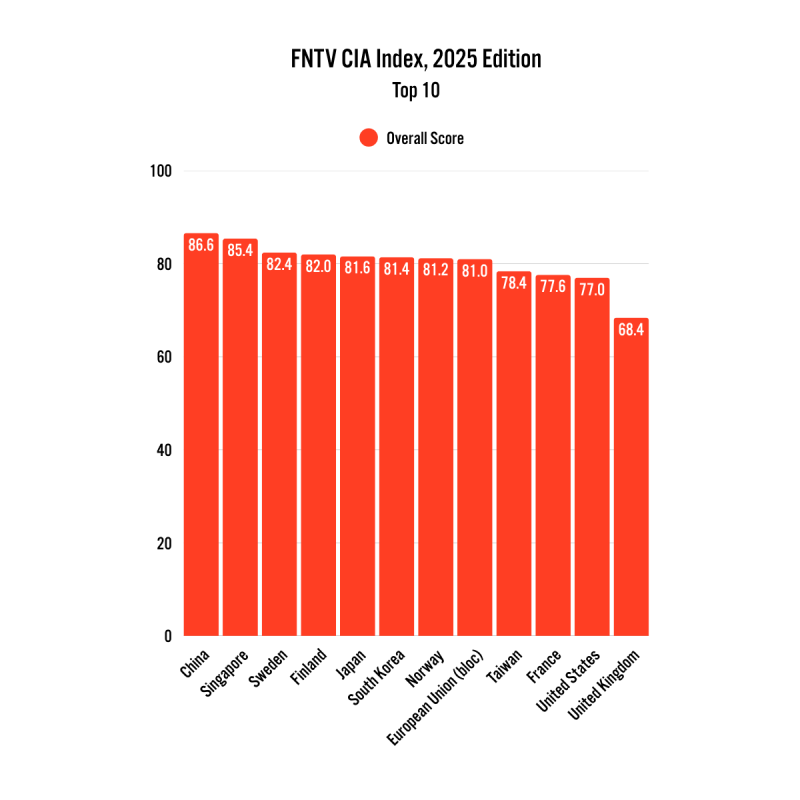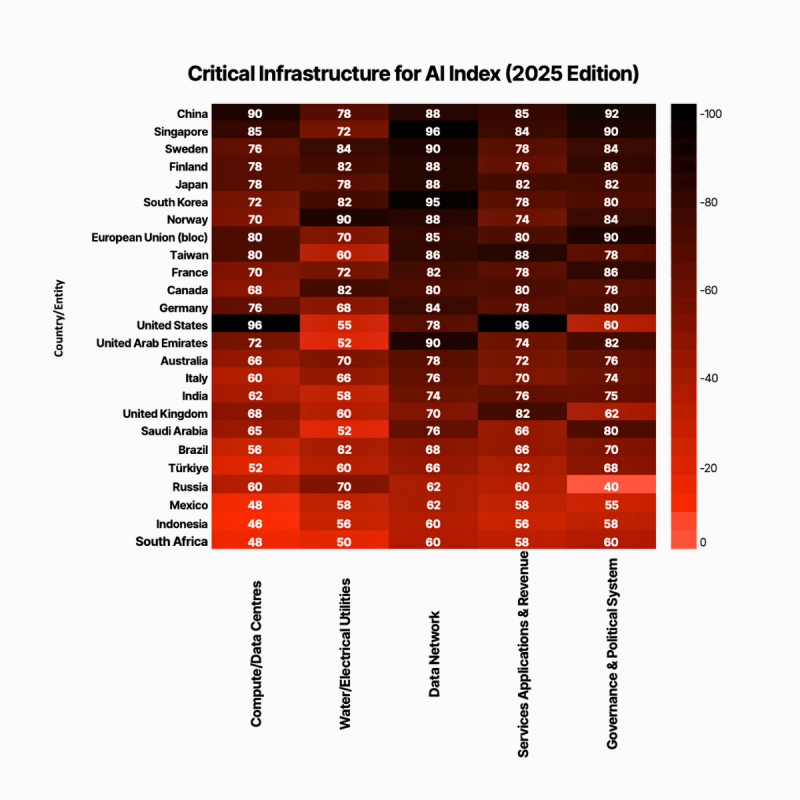- The top 25 global AI infra index is from FNTV, so you know it’s good
- Water, power and effective government are as crucial to national success as AI coding and chips
- AI requires a full AI stack to work. America doesn’t have it – and doesn’t “get it"
Which country is the world leader in AI? If you answered, “the United States,” you are correct, sir! But only up to a point.
The fact is that AI doesn’t exist in a vacuum. In addition to AI code and chips, and the giant data centers that house them, AI requires water to cool it, energy to power it, and the right network to carry it. And it needs a strong and effective government enacting a cohesive AI strategy to ensure all of these things happen for the good of the nation.
So which countries have the right mix of intellectual, physical, and governmental AI assets and which don’t? Here to answer that question, I am delighted to announce a shiny new FNTV feature:
The FNTV Critical Infrastructure for AI Index (CIA Index, 2025 Edition)

The Index evaluates 25 companies using the same criteria as FNTV’s AI five-layer stack (see figure), which takes a holistic view of AI’s requirements and potential.
Scores were calculated using AI, which seems appropriate. I used OpenAI’s Deep Research tool included in the pricey $200-a-month ChatGPT Pro subscription (tagline: for the research playas, yo!). To the results, then:
We have a winner!
China takes the top spot on the FNTV CIA Index, 2025 Edition, which will come as no surprise to anyone who’s been there, and a massive surprise to elected U.S. officials and investors who have not.
Teeny-tiny Singapore comes in second, punching far above its weight class, and demonstrating the advantages of implementing a national AI strategy when your country is the size of Monaco or Vatican City (bless).
Then come the Swedes and Finland in third and fourth, respectively, partly as a result of the presence of their incumbent telecom powerhouses, Ericsson and Nokia, which are leaders in 5G, the technology that underpins the entire Industry 4.0 revolution.
What about the U.S. and its yappy faux-socialist poodle, the United Kingdom? No Top 10 place for either – they sit in 13th and 18th, respectively.

FNTV will publish the next Index update next year. Will the U.S. do better, or worse? To get a sense of what’s coming, I recommend reading the President Trump administration’s recently published Winning the AI Race: America’s AI Action Plan (which could just as easily have been titled “American AI! F*** Yeah!).
It’s a slim tome. More of a national to-do list. But give it a read; it doesn’t take long, I promise. Or skip directly to page 24, and what serves as a terrific five-word summation of both America’s entire AI strategy and the cerebral capability of its latest Cabinet: “this page left intentionally blank.”
It’s all too little, 20 years too late, and the reality is that none (NONE) of its key recommendations will be implemented before President Trump leaves power. Without a national epiphany, America faces an ‘Emperor’s New Clothes’ situation when it comes to AI: all mouth and no trousers.
And that poses a larger question: in 10 years, will the U.S. even make the Top 25 ranking?

The methodology
Scroll down for an overview of the Official Methodology of The Critical Infrastructure for AI Index (CIA Index, 2025 Edition).
FNTV used Deep Research to create The Critical Infrastructure for AI Index, which does what it says on the tin, diving deeper into internet data than the other GPTs to produce better results. For now. That will change over the next couple of years as other analysts wake up to the power of the model, and the fact that the subscription is a banging tax deduction under Section 162(a) of the Internal Revenue Code (wink wink, say no more, lads).
Since the volume of timely and original human analysis decreases in proportion to the number of journalists, analysts, and consultants using AI chatbots to poach each other’s timely and original human analysis, at some point in the next few years, the whole ChatGPT artifice will collapse as Internet content eats its own tail. But for now, it provides results that are fresh and energising! (Not stale and enervating).
As with AI itself — or the actual CIA, for that matter — the Index isn’t perfect. For one thing, it’s subject to the hallucinatory nature of neural networks. And I also intentionally omitted some factors from the methodology to keep things moving:
Like death-cult meme-stock Palantir, search engine company Google, and online retailer Amazon, the Deep Research megabot didn’t consider ethics or morality. The Index also doesn’t factor in national education standards, not that its inclusion would have helped the ranking of the U.S., which is currently intent on dismantling higher learning under a spectacularly dim-witted Education Secretary whose only qualification for the role appears to be her marriage to a loud-mouthed wrestling promoter, and who thinks AI is called A1.
Index shortcomings notwithstanding and having seen in person the developments in most of the Top 25 countries evaluated, I concur with its rankings, which will be updated next year (2026).
Methodology
Scope of Countries
The index covers 25 countries and blocs:
- G20 members (excluding Argentina, because I can)
- Russia
- European Union (treated as a single bloc party)
- Six additional non-G20 nations chosen for their leading role in AI infrastructure and industrial digitalization: Singapore, Finland, Sweden, Norway, Taiwan and the United Arab Emirates (UAE).
This mix ensures both global economic weight and “hidden champions” that exemplify best practices.
AI infrastructure readiness pillars
The index evaluates each country across five equally weighted pillars (20% each), reflecting the five-layer stack required for an AI-enabled digital industrial economy:
1. AI code and innovation (20%)
- AI talent pool, publications, patents, and startup ecosystem
- R&D funding and commercialization of AI
- Presence of global AI labs or semiconductor fabs
2. Compute/data centers (20%)
- Availability of hyperscale and HPC infrastructure
- National GPU/accelerator capacity, supercomputers, semiconductor base
- Presence of cloud/hyperscaler footprints
3. Networks (20%)
- Broadband penetration, fibre coverage, 5G/6G deployment
- Latency and reliability
- Progress toward Level-4 autonomous networks (self-optimizing carrier systems)
4. Power and water (20%)
- Grid capacity, reliability, and interconnection times
- Electricity generation mix (renewables, nuclear, fossil)
- Water availability and cooling resilience (data centre siting, climate stress)
5. Governance and execution (20%)
- National AI strategies and regulatory frameworks (e.g. EU AI Act, China’s national plans, IndiaAI)
- Policy coherence and industrial AI alignment (telco-driven Industry 4.0 rollouts vs. consumer chatbots)
- Government capacity to implement infrastructure projects at scale
Data Sources and Scoring
- Quantitative data: Stanford AI Index, Synergy Research (hyperscale/DC), TOP500 (supercomputers), Opensignal/Ericsson (networks), DOE/ENTSO-E (power), WRI Aqueduct (water).
- Qualitative factors: National AI strategies, regulatory posture, industrial adoption case studies, and carrier L4 autonomy deployments.
- Weights: All pillars are weighted equally at 20% to avoid skew from overemphasizing raw compute.
- Scoring scale: 0–100 per pillar, normalized from metrics and expert judgment, then aggregated into an Overall Score.
Analytical Adjustments (2025)
- Power, water, and cooling constraints explicitly score as high as compute. This downgrades countries like the U.S. and elevates hydro/nuclear-rich nations (Norway, Finland, Canada).
- Industrial focus: Consumer AI strength (LLM labs, chatbots) is insufficient; priority is given to AI’s role in Industry 4.0 and telco-enabled edge deployments.
- Governance clarity: Nations with enforceable AI legislation or coherent long-term plans (China, EU, Singapore, Finland) score higher than fragmented regimes like the USA.
- Additions beyond G20: Inclusion of small but strategically significant AI nations (Nordics, Singapore, Taiwan, UAE) reflects their disproportionate influence on global AI infrastructure.
References
AI indices and benchmarks
- Stanford University (2025) AI Index Report 2025. Stanford Institute for Human-Centered Artificial Intelligence (HAI). Available at: https://aiindex.stanford.edu/
- Synergy Research Group (2024) Hyperscale data center capacity by country. Synergy Research.
- TOP500.org (2025) Top 500 Supercomputers List. Available at: https://www.top500.org/
- Opensignal (2024) Global Mobile Network Experience Awards 2024. Opensignal. Available at: https://www.opensignal.com/
- Ericsson (2024) Ericsson Mobility Report, November 2024. Ericsson.
Infrastructure and utilities
- Lawrence Berkeley National Laboratory (2024) U.S. Transmission Interconnection Queue Data. Berkeley Lab.
- U.S. Department of Energy (2024) Grid Modernization Strategy. DOE.
- European Network of Transmission System Operators for Electricity (ENTSO-E) (2024) Ten-Year Network Development Plan (TYNDP). Brussels: ENTSO-E.
- World Resources Institute (2024) Aqueduct Water Risk Atlas. Available at: https://www.wri.org/aqueduct
National strategies and governance
- European Union (2024) Artificial Intelligence Act. Official Journal of the European Union, L 202/1, 1 August 2024.
- Government of China (2017) New Generation Artificial Intelligence Development Plan. State Council of the People’s Republic of China.
- Government of India (2024) IndiaAI Mission. Ministry of Electronics & Information Technology (MeitY).
- U.S. Government (2023) Executive Order on Safe, Secure, and Trustworthy Artificial Intelligence. The White House.
- National Institute of Standards and Technology (NIST) (2023) AI Risk Management Framework. NIST, U.S. Department of Commerce.
- Government of Saudi Arabia (2020) National Strategy for Data & AI (NSDAI). Riyadh: SDAIA.
- Government of the United Arab Emirates (2017) UAE National Artificial Intelligence Strategy 2031. Dubai: Ministry of AI.
- Government of Finland (2017) Finland’s National Artificial Intelligence Strategy. Ministry of Economic Affairs and Employment.
- Government of Singapore (2019) National AI Strategy. Smart Nation and Digital Government Office.
- Government of Sweden (2018) National Approach to Artificial Intelligence. Government Offices of Sweden.
- Government of Norway (2020) National Strategy for Artificial Intelligence. Ministry of Local Government and Modernisation.
- Oxford Insights (2024) Government AI Readiness Index 2024. Oxford Insights.
FNTV/Saunders articles
- Saunders, S. (2025) AI holding out on telco. Fierce Network. Available at: https://www.fierce-network.com/modernization/op-ed-ai-holding-out-telco
- Saunders, S. (2025) AI opportunity heads to the edge. Fierce Cloud. Available at: https://www.fierce-network.com/cloud/ai-opportunity-heads-edge
- Saunders, S. (2025) AI bubble on the verge of bursting. Fierce Modernization. Available at: https://www.fierce-network.com/modernization/ai-bubble-verge-bursting
- Saunders, S. (2025) International carriers drive unexpected surge in L4 autonomous networks. Fierce Network. Available at: https://www.fierce-network.com/modernization/op-ed-international-carriers-drive-unexpected-surge-l4-autonomous-networks
- Saunders, S. (2025) AI’s full stack is looking a bit wobbly. Fierce Modernization. Available at: https://www.fierce-network.com/modernization/ais-full-stack-looking-bit-wobbly
- Saunders, S. (2025) Unregulated nuclear AI is here. Fierce Modernization. Available at: https://www.fierce-network.com/modernization/op-ed-unregulated-nuclear-ai-here
- Saunders, S. (2025) Snap, crackle, pop: US energy infrastructure can’t handle AI. Fierce Modernization. Available at: https://www.fierce-network.com/modernization/op-ed-snap-crackle-pop-us-energy-infrastructure-cant-handle-ai
- Saunders, S. (2025) 5G’s true potential: why analysts are missing the mark on industrial digitalization. Fierce Wireless. Available at: https://www.fierce-network.com/wireless/op-ed-5gs-true-potential-why-analysts-are-missing-mark-industrial-digitalization
- Saunders, S. (2025) How big is Industry 4.0? Bigger than you think. Fierce Network TV. Available at: https://www.fierce-network.com/fierce-network-tv/how-big-industry-40-bigger-you-think
AI in telecom isn’t tomorrow’s problem — it’s today’s imperative. If you’re waiting for it to catch up, you’re already behind. Join Fierce Network, Supermicro and Nvidia for an exclusive Accelerating AI Solutions for Telecom event at the Dallas Cowboys HQ. Click here to check your eligibility and register today.